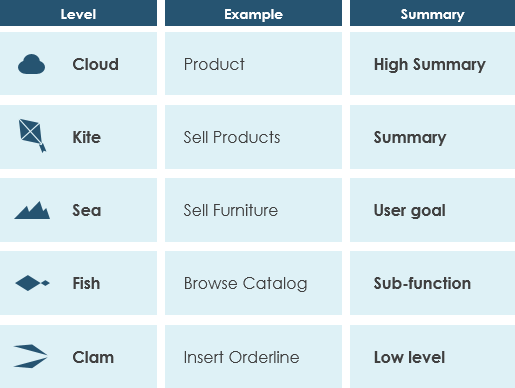Navigating Scope: The Impact of Cloud, Kite, Sea, Fish, Clam in Use Case Analysis
Introduction
In the dynamic world of software development, managing scope is a critical challenge. The concept of “Cloud, Kite, Sea, Fish, Clam” offers a unique lens through which we can understand and approach this challenge. This model, developed by Alistair Cockburn, provides a structured framework for breaking down and assessing the scope of software projects at various levels of granularity. In this article, we delve into how these scope levels affect the software development process, from project planning to resource allocation, communication, and beyond. Join us as we explore the profound impact of this model on the software development landscape.
What is Use Case Levels
Alistair Cockburn’s “Cloud, Kite, Sea, Fish, Clam” is a model that represents five different levels of scope in software development projects. Each level describes a different perspective or granularity of the project’s focus. Let’s explain each level:
-
Clam (Smallest Scope):
- Definition: At the “Clam” level, the scope is very narrow and focused on the smallest units of work within a software project.
- Use Case Example: Writing a single function or module within a larger software system, such as a login authentication module.
-
Fish (Small Scope):
- Definition: The “Fish” level expands the scope a bit to encompass a collection of related features or functions.
- Use Case Example: Developing a set of user management features, including user registration, login, and profile management.
-
Sea (Medium Scope):
- Definition: The “Sea” level represents a more substantial portion of the project, often involving multiple interconnected features or subsystems.
- Use Case Example: Building an e-commerce website with functionalities like product catalog, shopping cart, payment processing, and order management.
-
Kite (Large Scope):
- Definition: The “Kite” level encompasses a significant portion of the project, possibly the entire system or a major subsystem.
- Use Case Example: Creating an entire customer relationship management (CRM) system with modules for sales, marketing, and customer support.
-
Cloud (Largest Scope):
- Definition: The “Cloud” level represents the broadest and most comprehensive scope, typically covering the entire software project or a major product line.
- Use Case Example: Developing an entire enterprise resource planning (ERP) system that integrates various functions like finance, HR, manufacturing, and supply chain management.

The “Cloud, Kite, Sea, Fish, Clam” model by Alistair Cockburn helps teams and stakeholders understand the different levels of scope in a software project, ranging from small, focused tasks to large, comprehensive endeavors. This model can aid in project planning, communication, and prioritization by clarifying the level of granularity at which discussions or decisions are taking place.
Why Bother?
The “Cloud, Kite, Sea, Fish, Clam” model in software development affects us in several ways:
-
Project Planning and Scope Management:
- These concepts help project managers and teams define the scope of their projects effectively. They provide a framework for breaking down a large project into manageable pieces and understanding how different components fit together.
-
Resource Allocation:
- Understanding the scope at different levels helps in resource allocation. Smaller tasks (Clam and Fish) may require fewer resources, while larger tasks (Kite, Sea, Cloud) may demand more significant investments in terms of time, budget, and personnel.
-
Risk Assessment:
- Assessing the scope at various levels allows teams to identify potential risks and challenges associated with each level. Smaller tasks may have fewer dependencies and risks, while larger ones may be more complex and carry higher risks.
-
Prioritization:
- It helps in prioritizing work. When teams have a clear understanding of the different levels of scope, they can prioritize tasks and features based on their importance and dependencies, ensuring that critical elements are addressed first.
-
Communication and Collaboration:
- These concepts facilitate effective communication and collaboration among team members and stakeholders. Different levels of scope provide a common language for discussing project requirements, progress, and challenges.
-
Agile Development:
- In agile development methodologies, such as Scrum, the concept of breaking down work into smaller, manageable pieces aligns well with the Clam and Fish levels. Agile teams often work in short iterations, focusing on delivering smaller increments of functionality.
-
Customer and Stakeholder Engagement:
- Presenting the scope at different levels allows customers and stakeholders to better understand the project’s progress and what they can expect at each stage. This can lead to more meaningful feedback and expectations management.
-
Change Management:
- When changes or new requirements arise during the project, these concepts can help assess the impact on different levels of scope. Teams can evaluate whether a change affects a small, isolated component or has wider-reaching consequences.
-
Quality Assurance:
- Quality assurance and testing efforts can be tailored to the scope levels. Smaller units (Clam and Fish) can be thoroughly tested at the component level, while larger systems (Kite, Sea, Cloud) require integration and system testing.
-
Scaling and Growth:
- As a project progresses, understanding these scope levels becomes crucial when considering scaling and future development. Teams can plan for adding new features or expanding existing ones based on the existing scope.
Summary
The “Cloud, Kite, Sea, Fish, Clam” model has far-reaching implications for software development. It influences how projects are planned, resources allocated, risks assessed, and communication facilitated. Understanding the different levels of scope helps teams and stakeholders navigate the complexities of software development more effectively.
This article explores the multifaceted ways in which these scope levels shape the software development process, from agile methodologies to change management, and ultimately contribute to the successful delivery of software projects.

